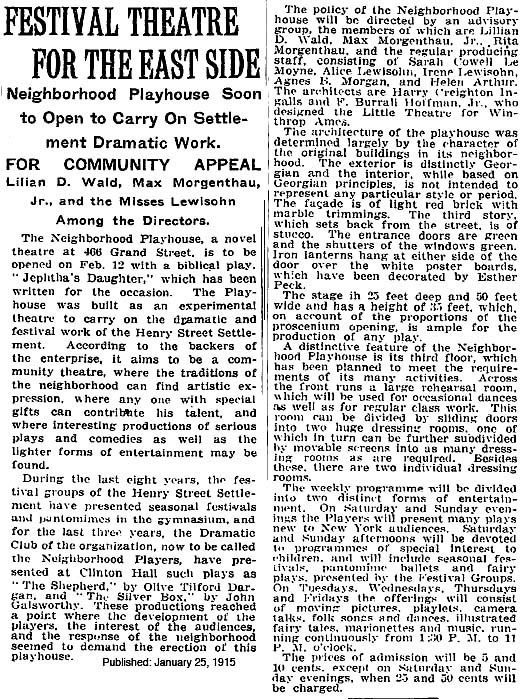
About Grace Spofford. An excerpt from the iawm journal
Then in 1935, she was named to what she came to consider her most important post-Director of the Music School of the Henry Street Settlement School in New York, an appointment that she would hold for nineteen years.
Spofford's decision to enter settlement work was typical of college educated women of her generation, who, in searching out ways to put their education and gifts at the service of society, found in settlement work a perfect outlet for their aspirations. At the Henry Street Settlement, Grace Spofford accessed yet another female network group which would energize her as she continued to work for social reform.
From the outset, Grace Spofford continued to use the collaborative processes that had become her modus operandi, surrounding herself with an excellent Music Committee which served as an Advisory Board. Its members included Lillian Wald, Helen Hall, Aaron Copland, George Gershwin, Jascha Heifetz, Felix Salmond, and Harold Taylor. Under Spofford's guidance, the Music School began to move in ways that made it more meaningful to the lower East Side community and enabled it to continue excellent musical standards and make important contributions to the field of music education.24 With the enthusiastic support of Henry Street Settlement House Director Helen Hall, the Henry Street Music School strengthened its already excellent programs.
A highlight of Spofford's early years at the Henry Street Settlement House occurred during the 1936-37 academic year-one year after Spofford's arrival. She convinced Aaron Copland, whom she had appointed to the Composition Faculty, to write a new work for the children at the school, one that would be suitable for performance by students, while simultaneously not sacrificing musical standards. Copland welcomed the challenge to write a piece that would be simple enough for youngsters to perform and that would allow him contact with the youth of America. The resulting work was a young people's "play opera" entitled "Second Hurricane," performed by children and young people ages 8-19 from the Music School, the Professional Children's School, the Seward Park High School, and the Adult Chorus of the Henry Street Music School. Many who were involved in the production went on to become prominent in their various spheres of the arts: conductor Lehman Engel, director Orson Welles, and actors Joseph Cotton and Charles Pettinger being the principals among them
Under Spofford's leadership, enrollment at the Henry Street Settlement Music School grew and faculty was expanded. In the 1940-41 season, the school could boast among its faculty pianist Isabelle Vengerova, violinist Ivan Galamian, harpist Lucile Lawrence, and composer Roy Harris, to mention but a few. By 1952 the school had 70 teachers and an enrollment of 900, ranging in age from 5-65 and representing 32 different national backgrounds. Although many of the students had made names for themselves in the world of music, Spofford's philosophy in educating the underprivileged was that "we are just as proud of the ones who marry and raise families or follow careers which have nothing to do with music."


























1 comment:
I'll always remember Miss Spofford with gretr admiration and affection for the times I spent at "Henry Street" as a violin student of Joseph Knitzer, Paul Makanovitsky and Mara Sebriansky. Most particularly in the 2nd chair 1st Violins next to Paul in the Mozart CHamber Orchestra directed by Robert Scholz and earlier by my other teacher, Louis Persinger. It was not just a musical privilege but a life experience as faculty members were members of the New Friends of Music Orchestra made up largely of refugees from Europe (1930's and '40's)The War in Europe came home to us there. Paul Makanovitsky cancelled a Carnegie Hall concert to enlist in, I believe, the Canadian or British air Force, and was shot down and wounded. His mother and sister were in Paris when it became occupied. I couldln't concentrate on studying violin further and went to work for the War Dept on the West Coast, returning later to music as a career after marriage and family. So I achieved two of Miss Spofford's stated goals. Knitzer also joined the service in wartime.I will always cherish the years at "Henry Street",
SIncerely, Mrs. Robin Fentress Kernan
Thank you Mr Bellel for posting the article. I would love to see the lists of personnel of the orchestra from 1938-1940?? Love to find surviving members. rk
Post a Comment